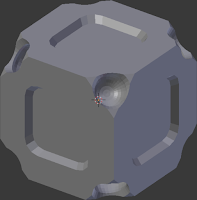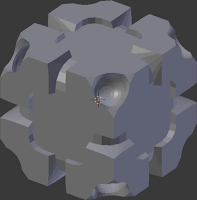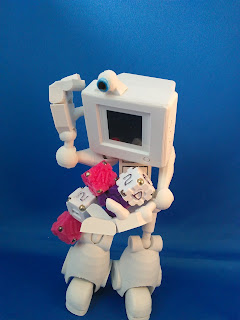So I might have gone a little bit space dice crazy. I think it’s out of my system now. Fortunately, you all get to reap the rewards. What follows is a descent into the madness of my mind via the medium of 3D printed dice, so strap in and enjoy the ride.
After I released my Space Dice models and made the video for them, I got a comment that the dice looked like I was ripping off the companion cube. Of course it has no hearts anywhere and therefore was more ripping off the weighted storage cube. But I can also claim it was completely accidental. When designing a dice and the word “space” is thrown in there it is inevitable to have protruding corners, and I don’t know why. Plus it just prints better when you’re trying to follow the YHT principles, which I am. Still, it got me thinking. And since there were avenues I wanted to but didn’t explore but didn’t because I wasn’t sure the idea wasn’t going to work, now that I know they work, I gave myself license to explore.
The Dice Body types
So here’s the 6 body types I came up with.
 |
Prototype: The first body type is the one that I came up with while modeling, but not the first one I released. It’s simply a recess in the side so that the numbers didn’t protrude. I could have recessed the numbers, but I didn’t. I’m glad I didn’t because everything that follows came because of this decision. This does vary slightly from the actual prototype dice because the corners are rounded, but I decided to go with it because it prints better. So this is more prototype plus. |
 |
Release Version: I realized that I could connect the recesses, isolating the corners, without affecting the magnets and that the result would look cool, so I did. And this was the version of the dice that I released. This was the point that I rounded the corners of the recess the first time, which motivated the next iteration… |
 |
Release Plus: While rounding the corners of the recess I wondered if I could also round the corners of the cut, giving the appearance of the inner cube being a rounded one capped with the protruding corners. I knew overhang might cover most of this, but decided not to push it at the time. No reason not to now, so here it is. The only real difference is the significantly rounded edges of the inner dice |
 |
Diamond Joe: Thinking about the protruding corners, I wondered if I could just straighten them out, so instead of going around the tip, they could be like a triangle around them. However, my first attempt was lazy, and I couldn’t push it too far without Boolean problems, so I ended up with this, a diamond shaped recess. And it’s pretty cool and gives a nice space. |
 |
Triangle Corners: But then I stopped being lazy, fixed the diamonds so they connected, and got the straight corners I wanted in the first place. The difference between this and Diamond Joe is subtle, but I feel significant to the feel. Diamond Joe is a recessed diamond hole, Triangle Corners is protruding diamond corners. It all depends on who connects I guess. |
 |
Gears: Lastly, gears. Because who doesn’t love gears?
This was actually motivated because of an inner monologue after the pips discussion that I’ll talk about below. Suffice it to say getting gears on the protruding corners was not easy. This went through many iterations with the teeth lining up at first, then me realizing that’s madness, so I rotated half the gears so the teeth would mesh, and them making them mesh, and then realizing that they were invading into the number’s space too much and so I backed them off again. I think the gear dice are probably the coolest ones and I wish I could make them just mesh but I’d have to redesign all the numbers to make that happen. Not saying I won’t make that happen, just that I’d need to. |
So there’s the 6 body type variations I came up with, some of them only subtly different from others, but enough that I can call them unique.
The Numbering Types
I also got the comment that the Arabic numerals on the dice were not the best, since 6 and 9 look like each other (even though 9 doesn’t appear on a 6 sided dice) and 2 and 5 look like mirrors, especially with this font (…okay, fair), and could I do pips instead? This kicked off the afforementioned inner monologue, that I will detail below as I go through the number options:
Arabic Numerals: Naturally my first number options was the NASA font, because these are space dice after all. But as mention, concerns were raised about the shortcomings of Arabic numerials, and so the traditional pips were requested.
Pips: Really? Pips? That’s fine for a 6 sided dice, or maybe as many as 10, but as a numbering system pips are just the worst. I mean what are you going to do when you’re trying to represent the square root of 8649, throw a bunch of dots on a piece of paper? I don’t think so. And don’t think that you can solve the problems with place settings like we do with Arabic numerals. The closes solution I can think of is to do things like they do in grade school with a connected grouping of 10 in a row for 10s and a block of 100 for hundreds, but that doesn’t solve the problem of eating up more space, just makes them faster to count. No, pips are the worst.
I propose something a bit more radical.
Intergalactic Numerals: What you see is my contribution to the question of what to do if you make first contact. See, the problem of communicating with an alien life form is that you need a communication system that is visually clear, assuming they have some ability to discern your primitive scratching on their containment wall, but that’s a whole other problem. Still, a visually clear works easily enough for nouns, but verbs and numbers are abstract and a little more tricky. I’m still working on verbs, but I have a solution for the numbers, and that solution is before you.
Look at it? Do I even need to explain it? Each shape has a number of corners and sides equal to it’s value. Period. Brilliant, right? You can see I’ve solve the questions of 1 and 2, which are tricky, but what about for really big numbers that become indistinguishable from circles? What about zero? I’ve got that covered. I don’t want to go too much into it. Suffice it to say the numbers cut off at 8 or maybe 10 and are then nested inside each other for the places, insuring the shapes never get too complex.
I’ve got a rather long discussion about this inside me involving bases and conversions, but suffice it to say that in my head this is the superior number system and should be adopted by everyone immediately and anyone who argues is a fool.
Roman Numerals: What’s that you say? My intergalactic numbers are too radical for you? You’d rather just stick with what you know? Fine. Here, have a numbering system that is so convoluted up it’s own principals that we keep it around only for when we want to seem fancy, because nothing says regal like something nobody can understand. Roman numerals are the numerical equivalent of the emperor’s new clothes, except no one is willing to point out the kings dangling exposure, even after all these thousands of years of it’s use. That should make you Neo-Luddites happy.
In truth I love Roman Numerals, but it was that indignant “Neo-Luddite” phrase that made me think of steampunk and thus motivated the gears body. See, got there in the end.
The Combinatorics
So with 6 body types and 4 number types there are 24 possible dice combinations. And if I keep doing the with/without supports versions of the files there will be 48 different STLs, which is just madness so the new files all come with supports, you can remove them if you absolutely have to.
In addition, these dice can easily be modified to earth bound versions by simply removing the holes in the corners for the magnets, creating another 24 different possible dice. That’s a total of 48 dice that I’ve created with this project.
The problem
- Model and test the prototypes,
- I had to model the parts that will be a part of the combinations,
- Boolean all the combinations together and export them one-by-one,
- Check one-by-one to make sure they don’t have any manifold problems,
- Fix the manifold problems,
- Make sure they print,
- Discovering that I had messed up the supports and they wouldn’t print,
- Fixing the supports for each one of them one-by-one,
- Check again for manifold problems,
- Test print a few of them,
- Upload them online,
- Consider editing the lime guy meme for a silly picture to make a joke for this section.






